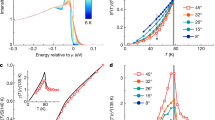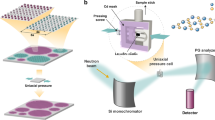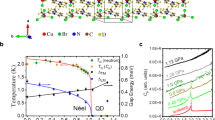Abstract
The elucidation of the pseudogap phenomenon of the high-transition-temperature (high-Tc) copper oxides—a set of anomalous physical properties below the characteristic temperature T* and above Tc—has been a major challenge in condensed matter physics for the past two decades1. Following initial indications of broken time-reversal symmetry in photoemission experiments2, recent polarized neutron diffraction work demonstrated the universal existence of an unusual magnetic order below T* (refs 3, 4). These findings have the profound implication that the pseudogap regime constitutes a genuine new phase of matter rather than a mere crossover phenomenon. They are furthermore consistent with a particular type of order involving circulating orbital currents, and with the notion that the phase diagram is controlled by a quantum critical point5. Here we report inelastic neutron scattering results for HgBa2CuO4+δ that reveal a fundamental collective magnetic mode associated with the unusual order, and which further support this picture. The mode’s intensity rises below the same temperature T* and its dispersion is weak, as expected for an Ising-like order parameter6. Its energy of 52–56 meV renders it a new candidate for the hitherto unexplained ubiquitous electron–boson coupling features observed in spectroscopic studies7,8,9,10.
This is a preview of subscription content, access via your institution
Access options
Subscribe to this journal
Receive 51 print issues and online access
$199.00 per year
only $3.90 per issue
Buy this article
- Purchase on Springer Link
- Instant access to full article PDF
Prices may be subject to local taxes which are calculated during checkout



Similar content being viewed by others
References
Norman, M. R., Pines, D. & Kallin, C. The pseudogap: friend or foe of high T c? Adv. Phys. 54, 715–733 (2005)
Kaminski, A. et al. Spontaneous breaking of time-reversal symmetry in the pseudogap state of a high-T c superconductor. Nature 416, 610–613 (2002)
Fauqué, B. et al. Magnetic order in the pseudogap phase of high-T c superconductors. Phys. Rev. Lett. 96, 197001 (2006)
Li, Y. et al. Unusual magnetic order in the pseudogap region of the superconductor HgBa2CuO4+δ . Nature 455, 372–375 (2008)
Varma, C. M. Non-Fermi-liquid states and pairing instability of a general model of copper oxide metals. Phys. Rev. B 55, 14554–14580 (1997)
Varma, C. M. Theory of the pseudogap state of the cuprates. Phys. Rev. B 73, 155113 (2006)
Lanzara, A. et al. Evidence for ubiquitous strong electron-phonon coupling in high-temperature superconductors. Nature 412, 510–514 (2001)
Yang, J. et al. Exchange boson dynamics in cuprates: optical conductivity of HgBa2CuO4+δ . Phys. Rev. Lett. 102, 027003 (2009)
van Heumen, E. et al. Optical determination of the relation between the electron-boson coupling function and the critical temperature in high-T c cuprates. Phys. Rev. B 79, 184512 (2009)
Lee, J. et al. Interplay of electron-lattice interactions and superconductivity in Bi2Sr2CaCu2O8+δ . Nature 442, 546–550 (2006)
Zhao, X. et al. Crystal growth and characterization of the model high-temperature superconductor HgBa2CuO4+δ . Adv. Mater. 18, 3243–3247 (2006)
Barišić, N. et al. Demonstrating the model nature of the high-temperature superconductor HgBa2CuO4+δ . Phys. Rev. B 78, 054518 (2008)
Eisaki, H. et al. Effect of chemical inhomogeneity in bismuth-based copper oxide superconductors. Phys. Rev. B 69, 064512 (2004)
Vignolle, B. et al. Two energy scales in the spin excitations of the high-temperature superconductor La2-x Sr x CuO4 . Nature Phys. 3, 163–167 (2007)
Hinkov, V. et al. Spin dynamics in the pseudogap state of a high-temperature superconductor. Nature Phys. 3, 780–785 (2007)
Rossat-Mignod, J. et al. Neutron scattering study of the YBa2Cu3O6+x system. Physica C 185–189, 86–92 (1991)
Yu, G. et al. Magnetic resonance in the model high-temperature superconductor HgBa2CuO4+δ . Phys. Rev. B 81, 064518 (2010)
Tranquada, J. M. et al. Quantum magnetic excitations from stripes in copper oxide superconductors. Nature 429, 534–538 (2004)
Pailhès, S. et al. Resonant magnetic excitations at high energy in superconducting YBa2Cu3O6. 85 . Phys. Rev. Lett. 93, 167001 (2004)
Grbić, M. S. et al. Microwave measurements of the in-plane and c-axis conductivity in HgBa2CuO4+δ : discriminating between superconducting fluctuations and pseudogap effects. Phys. Rev. B 80, 094511 (2009)
Norman, M. R. & Pépin, C. The electronic nature of high temperature cuprate superconductors. Rep. Prog. Phys. 66, 1547–1610 (2003)
Tahir-Kheli, J. & Goddard, W. A., III Chiral plaquette polaron theory of cuprate superconductivity. Phys. Rev. B 76, 014514 (2007)
Weber, C. et al. Orbital currents in extended Hubbard models of high-T c cuprate superconductors. Phys. Rev. Lett. 102, 017005 (2009)
Kivelson, S. A., Fradkin, E. & Emery, V. J. Electronic liquid-crystal phases of a doped Mott insulator. Nature 393, 550–553 (1998)
Sachdev, S. Quantum criticality: competing ground states in low dimensions. Science 288, 475–480 (2000)
Chakravarty, S. et al. Hidden order in the cuprates. Phys. Rev. B 63, 094503 (2001)
Simon, M. E. & Varma, C. M. Detection and implications of a time-reversal breaking state in underdoped cuprates. Phys. Rev. Lett. 89, 247003 (2002)
Hayden, S. M. et al. The structure of the high-energy spin excitations in a high-transition-temperature superconductor. Nature 429, 531–534 (2004)
Yamamoto, A., Hu, W. & Tajima, S. Thermoelectric power and resistivity of HgBa2CuO4+δ over a wide doping range. Phys. Rev. B 63, 024504 (2000)
Acknowledgements
We thank T. H. Geballe, S. A. Kivelson, E. M. Motoyama and C. M. Varma for discussions. This work was supported by the US Department of Energy and the US National Science Foundation, and by the National Natural Science Foundation, China. Y.L. acknowledges support from the Alexander von Humboldt Foundation during the final stage of completing the manuscript.
Author information
Authors and Affiliations
Contributions
M.G., P.B. and Y.L. planned the project. Y.L., V.B. and G.Y. performed the neutron scattering experiments. Y.L., N.B. and X.Z. characterized and prepared the samples. N.B. performed the resistivity measurements. P.S., R.A.M., K.H., Y.S. and P.B. were local contacts for the neutron scattering experiments. Y.L. and M.G. analysed the data and wrote the manuscript.
Corresponding author
Ethics declarations
Competing interests
The authors declare no competing financial interests.
Supplementary information
Supplementary Information
This file contains a Supplementary Discussion in 9 sections, Supplementary Data, additional references and Supplementary Figures 1-8 with legends. (PDF 6567 kb)
Rights and permissions
About this article
Cite this article
Li, Y., Balédent, V., Yu, G. et al. Hidden magnetic excitation in the pseudogap phase of a high-Tc superconductor. Nature 468, 283–285 (2010). https://doi.org/10.1038/nature09477
Received:
Accepted:
Published:
Issue Date:
DOI: https://doi.org/10.1038/nature09477
This article is cited by
-
Signature of quantum criticality in cuprates by charge density fluctuations
Nature Communications (2023)
-
Doping the holographic Mott insulator
Nature Physics (2018)
-
Mottness at finite doping and charge instabilities in cuprates
Nature Physics (2017)
-
Simulation of the NMR response in the pseudogap regime of the cuprates
Nature Communications (2017)
-
Photo-enhanced antinodal conductivity in the pseudogap state of high-Tc cuprates
Nature Communications (2014)
Comments
By submitting a comment you agree to abide by our Terms and Community Guidelines. If you find something abusive or that does not comply with our terms or guidelines please flag it as inappropriate.



